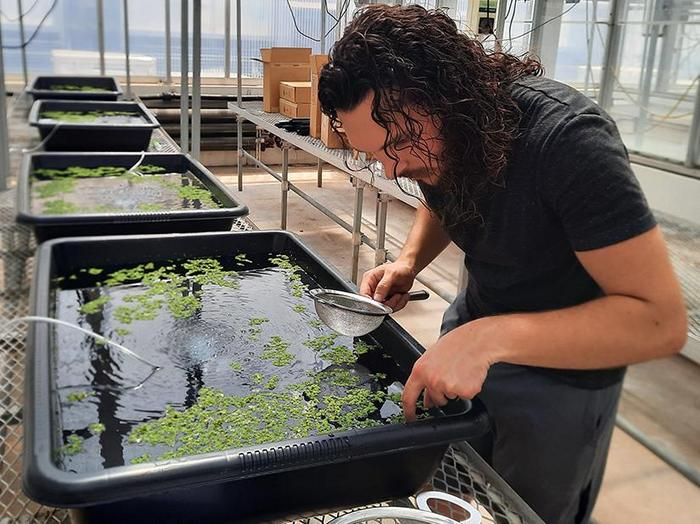Fast-growing plant could help reduce food insecurity globally, study finds
An often overlooked water plant could potentially serve as a life-saving food source in times of disaster or catastrophe.

An often overlooked water plant could potentially serve as a life-saving food source in times of disaster or catastrophe. The study was led by Daniel Winstead, pictured here. (CREDIT: Penn State University)
A study led by Penn State researchers suggests that an often overlooked water plant could potentially serve as a life-saving food source in times of disaster or catastrophe.
This plant, known as Carolina azolla or azolla caroliniana Willd, has remarkable capabilities: it can double its biomass in just two days, extract nitrogen from the air, making it a valuable green fertilizer, and it can be used as feed for poultry and livestock.
Recently published in Food Science & Nutrition, the study reveals that the Carolina strain of azolla, native to the eastern United States, may offer solutions to food insecurity.
The research, led by Daniel Winstead in collaboration with Michael Jacobson and Francesco Di Gioia from the College of Agricultural Sciences, sheds light on the potential of this plant in addressing food resilience challenges in the face of global catastrophes.
Related Stories
"Other species of azolla have been utilized worldwide for thousands of years as livestock feed and fertilizer due to their nitrogen-fixing abilities," explained Jacobson.
"However, the use of azolla for human consumption has been limited by its high polyphenolic content, which can affect digestibility. Our research shows that the Carolina strain has significantly lower phenolic content, and cooking the plant further reduces it."
Polyphenols, naturally occurring compounds in plants, are beneficial in moderate amounts due to their antioxidant properties. However, high concentrations can hinder nutrient absorption and act as antinutritional factors.
Native to the eastern U.S., Carolina azolla holds excellent potential for use as a fast-growing, short-season crop that requires minimal inputs, upkeep and processing, according to Penn State researchers. The plant — sometimes referred to as mosquito fern, fairy moss and water fern — could be used to increase the food supply. (CREDIT: Penn State University)
The study measured total phenolic content in Carolina azolla at approximately 4.26 grams of gallic acid equivalents per kilogram of dry weight, significantly lower than other azolla species commonly found in Asia and Africa.
To make Carolina azolla more digestible, the researchers tested three cooking methods: boiling, pressure cooking, and natural fermentation. These methods reduced the total phenolic content by 88%, 92%, and 62%, respectively, compared to the raw plant.
Winstead highlighted the nutritional value of Carolina azolla, describing it as having a crisp texture and a neutral taste.
The researchers found that the Carolina strain of azolla is more digestible and nutritious for humans than azolla varieties that grow in the wild and also are cultivated in Asia and Africa for livestock feed. (CREDIT: Penn State University)
"Its moderate protein and high mineral yields make this species desirable for cultivation," he said.
Moreover, its fast-growing nature and minimal input requirements make it an ideal resource during disasters and for smallholder farms and low-income areas.
The researchers tested three cooking methods that multiple studies have shown can decrease polyphenolic content in foods, with the aim of reducing antinutritional factors potentially restricting consumption of azolla — boiling, pressure cooking and natural fermentation, which is shown here. (CREDIT: Penn State University)
The potential applications of Carolina azolla extend beyond disaster relief. Jacobson emphasized its role in increasing agrobiodiversity and building resilient food systems. "Whether for immediate relief or long-term resilience planning, Carolina azolla has the potential to provide significant amounts of protein and calories for humans and livestock," he stated.
The study also aligns with ongoing research at Penn State, exploring regional, resilient food crops in the face of frequent disasters. Another paper by the same researchers, published in Frontiers in Sustainable Food Systems, examines the potential of lesser-used wild edible plants in North America.
In the study, Carolina azolla — which has been described as having a crisp texture and a neutral taste — was grown in a greenhouse located at Penn State's University Park campus. (CREDIT: Penn State University)
Marjorie Jauregui, a doctoral student in food science and international agriculture, contributed to the research. Looking ahead, the researchers aim to explore the viability of underutilized plants in African regions, furthering efforts to establish resilient food systems worldwide.
This research was funded by the Food Resilience in the Face of Catastrophic Global Events grant funded by Open Philanthropy and was supported by the U.S. Department of Agriculture’s National Institute of Food and Agriculture.
For more science and technology news stories check out our New Discoveries section at The Brighter Side of News.
Note: Materials provided above by The Brighter Side of News. Content may be edited for style and length.
Like these kind of feel good stories? Get the Brighter Side of News' newsletter.
Joshua Shavit
Science & Technology Writer | AI and Robotics Reporter
Joshua Shavit is a Los Angeles-based science and technology writer with a passion for exploring the breakthroughs shaping the future. As a contributor to The Brighter Side of News, he focuses on positive and transformative advancements in AI, technology, physics, engineering, robotics and space science. Joshua is currently working towards a Bachelor of Science in Business Administration at the University of California, Berkeley. He combines his academic background with a talent for storytelling, making complex scientific discoveries engaging and accessible. His work highlights the innovators behind the ideas, bringing readers closer to the people driving progress.



